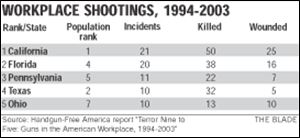
Experts: Work violence predictable, avoidable
1/28/2005
The triggers are well-known, the warning signs can be obvious, the results are almost always tragic.
Workplace violence has risen steadily for about a decade, prompting concern among a growing number of people who are studying it and offering solutions.
In 1994, there were fewer than 10 incidents involving worker-on-worker shootings. By 2003, there were 46 incidents that left 69 people dead.
Paul Viollis, a New York City-based consultant on workplace violence, said employers can develop programs to minimize violence while still watching out for clues of impending tragedy.
"It's completely avoidable and it's never spontaneous," Mr. Viollis said.
At Toledo Jeep, supervisors are taught how to handle disgruntled workers, said Harvey Deaton, a production supervisor at the old Jeep plant. He said supervisors have to be skilled to figure out how to motivate workers.
But even with the classes and the on-the-job knowledge that supervisors develop, Mr. Deaton, 61, said it's a difficult job. He said he and other supervisors long have acknowledged how easily a worker could snap.
"We can understand perfectly how someone can just go off, the stress and the strain," he said.
If someone is nearing that point, Mr. Viollis said the signs often are obvious.
They may make indirect threats to co-workers about the supervisor. They may be prone to loud outbursts, yelling, dropping things. The warning signs then get more serious, like direct threats to the supervisor, Mr. Viollis said.
Long before it gets to that point, employers can help avoid violence by creating safe, secure workplaces, said Francois Courcy, a professor of psychology at the University of Sherbrooke in Quebec.
He studied the organizational climate of different employers and found that workplace violence was far more prevalent where employees didn't feel they were respected by their superiors or co-workers.
"If people don't feel like they're appreciated, they react," Mr. Courcy said.
He said it's important for employers not to tolerate even the smallest forms of "violence," be it gossip or negative comments between workers.
"If you tolerate this, the gravity of the comments and the acts get more violent," Mr. Courcy said. One company outside Montreal took the outrageous step of allowing workers to fight - outside the building - once a week, he said.
Mr. Viollis said it is important for employers to make sure everyone - managers, supervisors, workers - treats each other with respect. Anything else cannot be tolerated, he said.
"Chronic condescending behavior is a very clear, well-documented factor that promotes workplace violence," Mr. Viollis said.
Over the years, as the incidents have multiplied, experts have crafted profiles of the shooters and their motives. Layoffs, firings, suspensions, or other disciplinary action are frequent causes of workplace violence, experts say.
In the Toledo North Assembly Plant incident, gunman Myles Meyers was involved in a meeting with supervisors over his work performance. Meyers also went into the plant with a clear intent: It wasn't random, police say, but directed specifically at his supervisors.
And in the end, Meyers turned his shotgun on himself. Nearly a third of the workplace shootings from 1994-2003 ended in suicide.
Contact Mike Wilkinson at:
mwilkinson@theblade.com
or 419-724-6104.